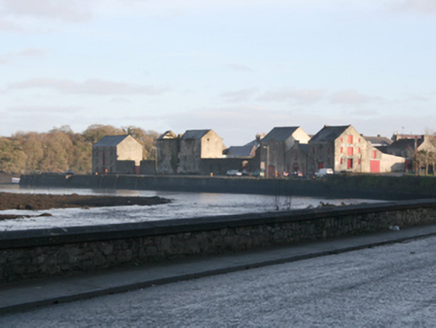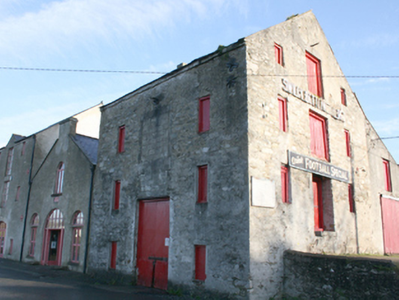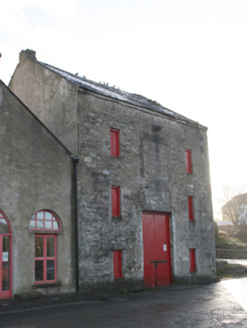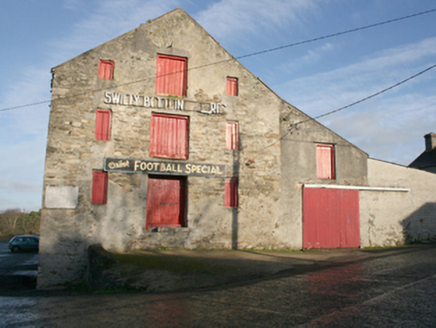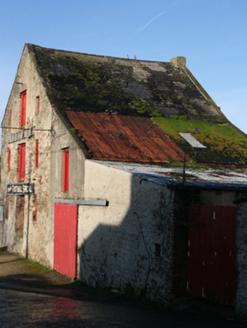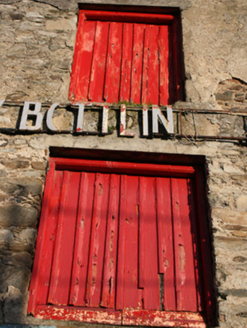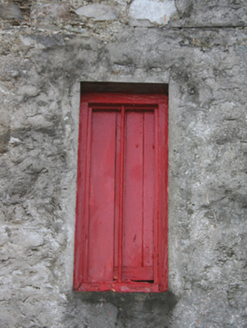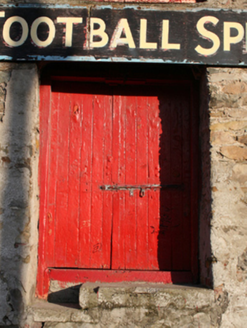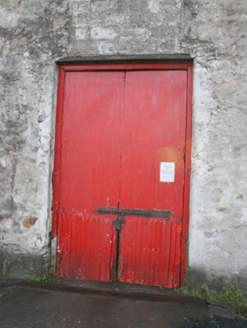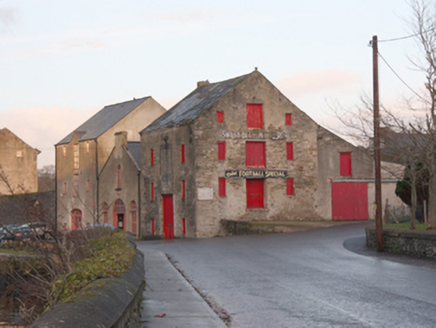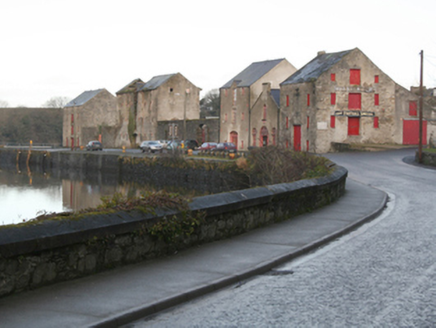Survey Data
Reg No
40800409
Rating
Regional
Categories of Special Interest
Architectural, Technical
Previous Name
Swilly Bottling Stores
Original Use
Store/warehouse
Historical Use
Factory
Date
1810 - 1850
Coordinates
222820, 421275
Date Recorded
10/06/2014
Date Updated
--/--/--
Description
Attached corner-sited three-bay four-storey former warehouse\store having attic level, built c. 1830, having single-bay two-storey addition to the rear (east), added c. 1900, with single-bay single-storey addition to the east, added c. 1930. Later in use as a bottling facility. Now out of use. Pitched natural slate roof to main body of building having projecting eaves course, surviving sections of cast-iron rainwater goods, clay ware ridge tiles, raised rendered verges to the gable ends, and with rendered rubble stone chimneystack to the north gable end. Partially lime roughcast rendered rubble stone walls with flush roughly dressed and squared quoins to the corners. Two cast-iron pattrice plates to the south-west corner of the front elevation (west) at second floor level. Flush timber fascia board\sign to south gable wall over ground floor openings with painted text reading ‘Drink Football Special’; sign over at second floor level having cut-out timber lettering reading ‘Swilly Bottling Company’. Square-headed window openings to the outer bays to both the main (west) and the south elevations having battened timber shutters, and with central wrought-iron security bars to a number of openings to both elevations. Square-headed former loading bays to the centre of the front elevation (west) at first and second floor levels, now infilled with modern blockwork; wrought-iron winch mechanism over second floor opening. Enlarged square-headed carriage-arch to the centre of the front elevation having battened timber double-doors (corrugate-metal to base), and with steel beam over. Square-headed loading bays to the centre of the south elevations having battened timber doors and double-doors; wrought-iron winch mechanism over second floor opening. Attached single- and two-storey additions to the rear (east) having mono-pitched corrugated roofs, rendered walls, and square-headed openings with timber fittings. Random rubble retaining wall to south gable with raised ground level\platform giving access to first floor of building. Road-fronted to the north\north-east end of the Quay, Ramelton. River Leannan adjacent to the west. Complex of former warehouses\stores adjacent to the north (see 40800405 to 40800408).
Appraisal
This impressive and imposing former warehouse\stores forms part of an important collection of buildings of this type aligning the historic quayside at Ramelton. Although out of use for a considerable period, and with some later additions to the rear, it survives in relatively good condition. Its corner site gives it a prominence in the streetscape. Its integrity is enhanced by the retention of salient fabric such as the natural slate roof and battened timber doors. It is robustly constructed in rubble stone masonry, a feature of the surviving warehouses at Ramelton. This building is one of the earliest surviving former warehouses at Ramelton (depicted on Ordnance Survey first edition six-inch map of c. 1837); many of the other warehouses to the north are later additions, c. 1860. It serves as an historic reminder of the town’s industrial and maritime heyday during the late eighteenth and nineteenth centuries. Ramelton prospered during the eighteenth and nineteenth century as a major port with trade with Britain, Norway, America, and the Caribbean, particularly important (there are accounts of ships from the Caribbean anchored in Lough Swilly and unloading exotic cargoes at Ramelton in exchange for linen, corn, meat and fish). Ramelton had the most important linen works in Donegal and many fortunes were made in the locality in its trade. The Watt family ran the largest linen works in the area by the start of the nineteenth century and were heavily involved in its trade (Samuel Watt moved to Jamaica in the early 1800s and began importing linen from Ramelton, with his brother James as agent). Corn was another major commodity in the area during the eighteenth and nineteenth centuries with a number of large mills still surviving in the area. The surviving warehouses, particularly aligned along the north-east end of the quay, attest to the level of trade and commerce in the Ramelton area. Slater’s Directory of 1846 records that ‘vessels of up to one hundred and fifty tons burthen can come up to the quayside [at Ramelton] at high water, and others, almost of any tonnage, can approach within half a mile of the town’. The town and port declined in importance towards the end of the nineteenth century, and the establishment of a railway line to nearby Letterkenny in 1909, with no rail link being built to Ramelton, hastened this decline. This building was later in use as a bottle store or bottling plant by the Swilly Bottling Company. A plaque to site (not seen, possibly removed) records that ‘The Hanging Gale’, a BBC series (1995) set in 1846 at the start of the Great Famine, was filmed in Ramelton. This former warehouse\store forms part of an important collection of industrial structures that contributes substantially to the almost unique character of the town of Ramelton, and is an integral element of the built heritage of County Donegal.
